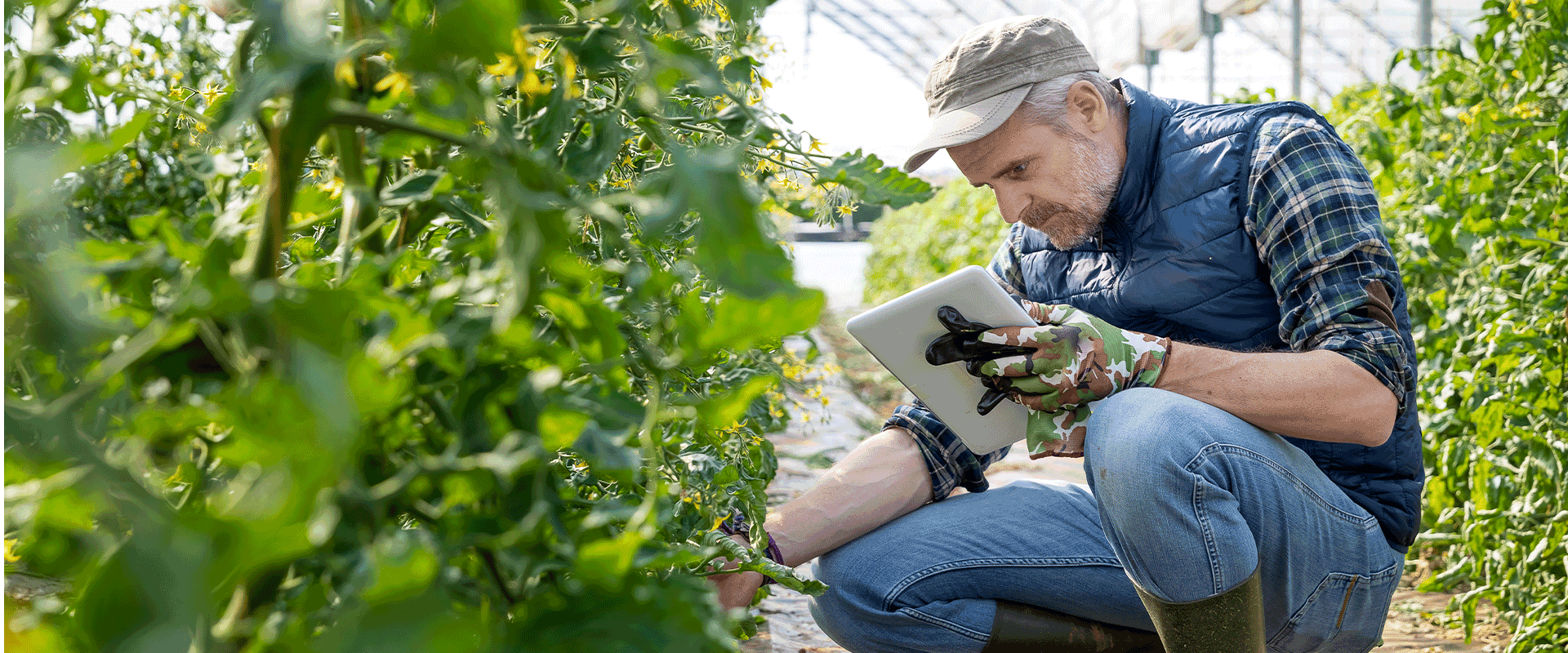We recently held an in-depth conversation about sustainability’s impact on the agribusiness industry with two leaders in L.E.K. Consulting’s Agribusiness sector: Peter Walter, Managing Director and practice head, and Michael Kaufman, Principal. Excerpts from our wide-ranging discussion can be found below.
How is sustainability defined in agribusiness?
Peter Walter: At the most basic level, sustainability within agribusiness is all about meeting the challenge of feeding 9 billion people by 2050 in a more efficient, productive and less damaging way to the planet’s soil, water and air. However, once you double-click on any specific part of the agribusiness value chain, from row crop cultivation to protein production to fruits, nuts and vegetables, you begin to see there are literally hundreds of ways that sustainability is being applied and can be defined within the industry.
Part of this is a trend toward sustainable “intensification,” which is the umbrella concept of how you produce more of what we need with better efficiency and better resource utilization per unit of food produced. Whether through conventional plant breeding techniques, genetically modified organisms (GMOs), crop biologics or biostimulants, the ag-biotech industry has driven a slew of innovations to help make crops higher yielding, more resistant to pests and disease, and in some cases, more resistant to climate risks such as drier conditions.
Thankfully, the intensification of crop cultivation has led to significant increases in crop yields and total food production, helping meet the needs of a growing population. However, the industry’s success with intensification has created other issues that are now in the crosshairs of sustainability efforts, including soil health concerns from overuse of crop chemicals and fertilizers, and nutrient runoff into water systems.
Organic farming and the nascent but quickly growing regenerative farming movement are both rooted in the goal of growing food in a more sustainable way for the long term. In addition, these and other types of cultivation approaches, such as no-till farming, offer powerful ways to trap atmospheric carbon in the soil, and potentially to pay farmers for doing so.
Within the protein production side of agribusiness, sustainability again takes many forms. The entire aquaculture industry, which now produces more seafood globally than is caught wild, is a sustainability movement given the ongoing decline of wild fish populations. Large producers of poultry, pork and beef are finding successes in improving the gut health and nutritional uptake of animals through probiotics, prebiotics, specialty enzymes and other mechanisms. And for the beef industry in particular, a lot of thought has been going into how to effectively capture the methane greenhouse gas emissions that cows produce naturally.
You mentioned the overall target of feeding 9 billion by 2050. Do you think that can be achieved? What will it take to get there?
Peter: I am very confident that we’ll get there, given the continued innovation, effort and investment made by so many investors, new entrants and established companies across the industry. It’s also important to note that food security, including both availability and affordability of food, is at the top of the agenda for virtually every country in the world and will remain that way.
That said, it will take pulling a range of levers in a coordinated way to ensure that we reach that goal economically and sustainably. Just in the past 10 years, an explosion of R&D and technology advancements has driven a large portion of the food productivity and sustainability gains we’ve seen over that period, and this will only accelerate going forward. The agribusiness industry will also need to continue to understand and meet the needs of downstream brands and consumers, as well as work to change misperceptions about the critical role of science and technology in ensuring our future food supply.
In addition, plant proteins are a key part of the solution for how we feed the planet sustainably. The past few years have witnessed a step change in this direction, with a significant uptick in the supply and range of plant-based proteins available from new entrants and traditional meat producers alike. There is certainly a meaningful and growing share of the global and U.S. population gravitating toward more plant-based proteins in their diet. And while animal proteins are not going to disappear, both options will increasingly sit side by side in grocery stores and on restaurant menus.
Will we see shifts in how crops are grown, as well as in which crops are grown where? For example, will it still be possible to grow fruits and vegetables in California given water scarcity?
Peter: Ongoing changes to the Earth’s climate have gradually been impacting where it’s optimal to produce a whole range of crops.
There has already been a shift in growing regions for certain crops, including orchard and vineyard crops in California, which have been shifting northward into Oregon and Washington. I believe that we will continue to see this happen across a wider range of both specialty and row crops over the coming decades.
We will also see much more growth in controlled-environment agriculture (CEA) and greenhouse growing capacity, even for crops that really haven’t been grown indoors to date at all, much less at scale. Crops such as tomatoes are further along the indoor growing curve, while there has been significant growth in CEA production of leafy greens, herbs, microgreens, garden vegetables and, lately, strawberries, in high-tech greenhouses and vertical farming environments. There are sustainability implications — positive ones — as that trend progresses.
Michael Kaufman: In terms of shifts, look at avocados. The cost of water in California has driven avocados slowly out of the U.S. There are still a few producers left, but production has gone away, by and large, with Mexico and Peru now being the big producers. As Peter mentioned, grape and cherry growers are moving from California to Oregon and Washington because of the climate shift and the need to adapt to changing environments.
So in response to climate change, there already has been and will continue to be some reshuffling of the supply landscape.
We’ve talked about crops, as well as shifts toward plant proteins. What are some other important issues related to sustainability in agribusiness?
Peter: As much as many consumers enjoy eating burgers and steaks, methane produced by cattle is a huge contributor to climate change that has received a lot of attention recently. A lot of money is being spent on responsible, effective technologies that can capture methane, and trap it and convert it to less harmful byproducts before it gets out into the atmosphere. For example, Cargill has pledged by 2030 to reduce methane emissions in its beef operations by 30%.
Overall, animal protein production growth represents a big challenge. Despite a new emphasis on protein from plants, most people still want to eat some form of animal proteins, and at affordable prices. When you think about the protein demand growth implications of a growing global middle class, the challenge of meeting this demand — and producing the crops required to feed these people — becomes a daunting one. Given consumer and trade interest, the plant-based proteins category is undergoing rapid growth right now — and that growth is expected to continue, with peak penetration of plant-based meats reaching 15%-20% of the broader animal protein category.
To what extent is the investment community driving these changes?
Michael: The investment community, defined as financial investors including private equity, venture funding, and pension funds and other institutional investors, has been actively investing in and supporting these changes. Plant-based protein is a great example, with private capital being some of the early supporters of Memphis Meats, Beyond Meat and Impossible. But you see it in other areas too — CEA, aquaculture and numerous other fronts.
You also have corporate investment helping drive these changes. Many of the large agriculture companies are not only investing internally, but also using corporate venture arms, partnership or other avenues to help fund startups right alongside financial investors. These strategic investors are not just chasing the financial return; they are also looking to get early access to new opportunities and technologies.
So what you’re really seeing are these big companies that are actively monitoring innovations and disruptions and getting in really, really early.
When big companies invest in these plant-protein startups, what’s their goal? To drive innovation or to avoid being disrupted? Or both?
In the automobile industry, there are questions about consumer demand for electric vehicles. Is there strong consumer demand for plant-based and otherwise sustainable food products?
Peter: I think it’s there but in different shades. If you’re a vegan or vegetarian, this movement is fantastic, because you now have a much broader and more widely available set of products to choose from. Maybe you missed, say, the taste of chicken, but now you have some better alternatives that are enjoyable and plant-based, so you’re happy.
There are many, many people who don’t want to ever eat plant-based proteins, and for them, there will always be animal proteins available. But the most interesting group of consumers — often called flexitarians — is somewhere in between the others. They comprise a middle ground of people who will still eat meat but may decide that every third or fourth burger is going to be plant-based. A good example of this “toning down” is Meatless Monday. They want to do what they feel is healthy for themselves and the planet. A lot of people fit into that segment, and evidence shows that a growing number of consumers are exploring changes in their diets. As the plant-based meat alternatives improve in taste, texture and clean-label ingredients, this dynamic will likely accelerate further.
Are younger consumers driving a generational shift toward sustainability?
Michael: Definitely. Younger people are the ones who tune in to these sorts of issues. Be it through their personal networks or online social networks, many young people are at the forefront of demanding these changes, especially through the power of the purse when they flock to brands that are promoting their sustainability efforts. And as you see those brands gain traction, others have taken notice and changed not only their messaging, but also their business practices. And while it’s true younger people are helping drive these changes, don’t discount the efforts of people across the spectrum — young and old, urban and rural, wealthy and poor, and so on. There are pockets of support driving change all over the country.
It sounds as though this industry is moving faster than many with regard to sustainability. What are the barriers?
Peter: There’s a lot of counterpressure from the meat companies that aren’t making this conversion, and many of their points are valid. For one, how much more sustainable are plant-based proteins relative to animal proteins? What are the other sustainability trade-offs that plant-based proteins introduce? Another critique of plant-based proteins is that they are not a very healthy or clean-labeled food product. If you look at ground beef, there is only one ingredient — beef. By contrast, many plant-based meat alternatives have a long list of unfamiliar sounding ingredients and may include ingredients some consumers prefer to avoid such as soy protein and wheat gluten. As a result, plant-based brands and ingredient providers are actively working to improve the clean-label profile of plant-based proteins.
Michael: And there could be some constraints in the ability to scale up some of the key ingredients like heme, the red, juicy, bloodlike substance that gives plant-based protein products a realistic mouthfeel (i.e., the texture of food and how it feels in your mouth). The ability to scale up, and do so in a sustainable way, may take some time and could possibly present a whole new set of challenges that we have yet to confront. We will get there, but it may take some time.
We’re talking so far about voluntary behavior on the part of companies and consumers, but is there regulatory pressure either at home or globally that is apt to have an impact?
Peter: There are several public sector efforts being made to help incentivize crop farmers to undertake more sustainable farming practices (e.g., cover cropping, no-till/reduced till) in places such as California, Germany, Austria and Australia. To be clear, these are not hard regulations with mandatory compliance requirements, but rather efforts to compensate farmers for successfully sequestering atmospheric carbon in their fields. For example, California’s Healthy Soils program provides grants to farmers based on their plans for implementing sustainable practices, while other programs are trying other approaches, including paying farmers for each ton of carbon that they can measure as being sequestered. Ultimately, voluntary, incentive-based approaches will almost certainly be more effective than strict regulations.
How has COVID-19 impacted sustainability efforts across the industry?
Peter: During the initial few months of COVID-19 lockdown, back in March and April, sustainability efforts definitely took a back seat to the more critical priorities of ensuring farmers had what they needed in order to plant their crops, as well as keeping meat processing plants running and their employees healthy. However, ag companies and farmers have not curtailed their sustainability plans, and now that the industry has largely adapted to the COVID-19 environment that we’re still in, sustainability initiatives are back in the front seat again.
What will the industry look like by 2050? What companies may still be around, and which will vanish? Who might lead?
Peter: There will be a lot of big changes driven by sustainability efforts in the agribusiness sector over the next 30 years. For one, we will see a substantial increase in the percentage of row crop acres producing crops using sustainable techniques, whether organically, regeneratively or otherwise. Additionally, the share of protein coming from animals vs. plant-based sources will be considerably lower than it is today. CEA will account for a much higher share of the greens, vegetables and even fruits that we eat. These are just a few examples of many.
Michael: Beyond that, there are the still nascent aspects of sustainability that we cannot yet project and those that have not yet been invented. For example, there are still questions as to whether a company can crack the code on cell-based, lab-based meat culture technology. That could be a game changer, but the technology is still nascent, and there’s been no consumer testing of either the product or the messaging. And there will surely be new innovations that change the industry that have not been thought of yet.
Peter: And then the other companies that deserve attention and have a lot of potential are the CEA companies. Certain crops, mainly salad greens, herbs, garden vegetables (e.g., tomatoes, peppers, cucumbers) and microgreens, are increasingly being grown profitably indoors, either in high-tech greenhouses or vertical farming environments. There has been a tremendous growth in the acreage of CEA facilities in the U.S. in recent years, and the trend appears to be accelerating.
The sustainability dimension of this trend is significant. It’s not just that indoor growing requires less water. These indoor crops require very few chemicals. And the risk of contamination and pathogens — like those associated with the romaine lettuce recalls we’ve seen — is greatly reduced. Also, with the addition of solar and wind power, indoor growing will evolve toward a closed loop when it comes to energy resources and water nutrients. That will dramatically reduce things like fertilizer runoff.
Down the road, due to climate change, indoor growing might become even more of a necessity, as the natural climate could become too variable in key specialty crop regions for us to rely on it, at least for some crops.



